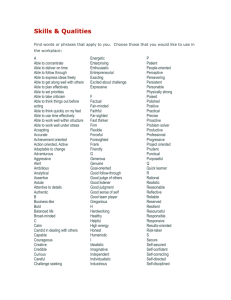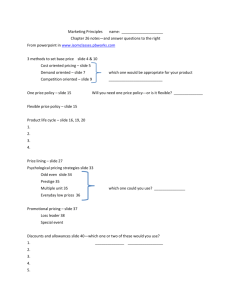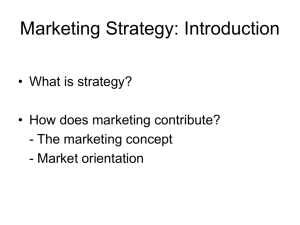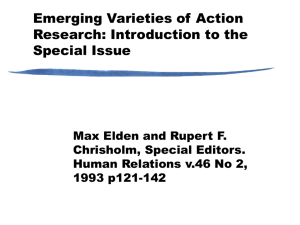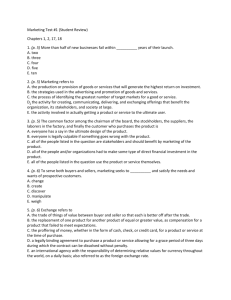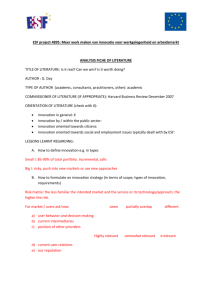Oriented Coloring: Complexity and Approximation
advertisement
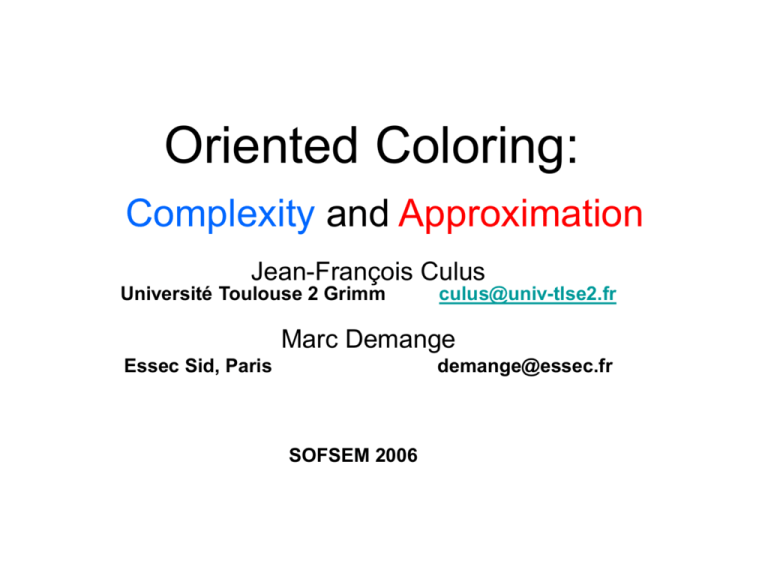
Oriented Coloring:
Complexity and Approximation
Jean-François Culus
Université Toulouse 2 Grimm
culus@univ-tlse2.fr
Marc Demange
Essec Sid, Paris
demange@essec.fr
SOFSEM 2006
Presentation
• 1. Introduction
What is an oriented coloring ?
• 2. Complexity
How difficult is it ?
• 3. Approximation
How to solve it ?
• Notations:
G=(V,E) graph
G=(V,A) oriented graph
Introduction:
Oriented Coloration & Coloration
Coloration as
vertices partition
Homomorphism
Oriented Coloring as
vertices partition
Oriented
Homomorphism
1. Introduction
Homomorphism
• Let G=(V,E) and K=(V’,E’) be graphs.
• An homomorphism from G to K is an application
f: V
V’ such that
{x;y} E {f(x);f(y)} E’
x
y
a
f(x)=f(t)=a
f(y)=b
f(z)=c
z
t
G
c
b
K
1. Introduction
Coloration and Homomorphism
• G admits a k-coloration if and only if
it exists a k-graph K and an homomorphism
from G to K.
• (G)=minimum k such that G admits a k-coloring
or there exists an homomorphism from G to K
k
K3
G
Coloration as
Vertices partition into
independent sets
1. Introduction
Oriented homomorphism
• Let G=(V,A) and K=(V’,A’) be oriented graphs.
• An oriented homomorphism from G to K is an
application f: V
V’ such that:
(x;y) A (f(x);f(y)) A’
x
y
z
t
u
v
a
b
c
f(x)=f(t)=f(v)=a
f(y)=f(u)=b
f(z)=c
1. Introduction
Oriented Coloring as Oriented Homomorphism
• Digraph G admits an oriented k-coloring iff
there exists an oriented k-graph K and an oriented
homomorphism from G to K.
• o(G)= the minimum k such that G admits an koriented coloring.
x
y
z
Call K-coloring
u
G
v
K
1. Introduction
Oriented Coloring as vertex partition
• An k-oriented coloring of digraph G=(V,A)
is a k-partition of V into independent sets
such that
x,x’Vi; y,y’Vj; (x,y)A (y’,y) A
x
x’
Unidirection property
y
y’
Oriented coloring: Example
x
y
A
z
Non locality of the oriented coloring
B
Note: Digraphs are antisymmetric
X
Y
2. Complexity: Plan
Oriented k-coloring
NP-complete case
Polynomial Case:
Oriented Tree
Extention ?
Homomorphism
NP-complete case
Extention ?
Another polynomial case!
2. Complexity: Homomorphism
• G=(V,A) digraph admits an oriented k-coloring iff there
exists K an oriented k-graph such that G Hom K
• Theorem [Bang-Jensen et al., 90]
T-coloring is NP-complete iff T has 2 circuits
• Smaller tournament T :
3-Oriented Coloring is Polynomial
4-Oriented Coloring is NP-Complete
[Klostermeyer & al., 04]
H4
… even for connected graph
2. Complexity
Polynomial case
• Easy on oriented trees o(G) ≤3
polynomial algorithm
Oriented Tree
Bipartite oriented graph
NP-complete !!
Circuit-free
oriented graph
Sketch of proof: Bipartite
Reduction from 3-Sat
• L admits a H4-coloring
• For each litteral xi
• For each clause Cj
Cj= z1 z2 z3
L
T
R
H4
B
F
2. Complexity: NP-Complete
• Theorem: k-Col is NP-Complete for k≥4
even if G is a Connected oriented graph
even if G is a bipartite
Planar
even if G is circuit free
Bounded degree
Complexity: Bipartite and Planar?
• Reduction from Planar 3-Sat.
For
For each
each clause
litteral xi
2. Complexity: Polynomial case
• k-colo is polynomial for complete multipartite
oriented graphs.
o(G)= (G1) + (G2) +…+ (Gp)
G1
G2
x
y
z
u
t
v
G1 is a cograph:
[Golumbic, 80]
(G1) could be obtain in
polynomial time.
3. Approximation: Plan
• Introduction: What is it?
Negative result !
Inapproximability
Analysis of the Greedy Algorithm
Positive Result
Minimum Oriented Coloring
(MOC)
3. Approximation
What is an approximation ?
• Min Oriented Coloring (MOC) Minimization problem
• Let G be a n-digraph
Optimum: o(G); Worst: n; Algorithm A(G)
0
o(G)
A(G)
n
• Classical ratio : r(n) = o(G) / A(G) ≤ 1
• Differential ratio: r(n) = (n-A(G)) / (n - o(G)) ≤ 1
3. Approximation
Reduction from Max Independent Set (MIS)
• Theorem: There exists a reduction from MIS to MOC
transforming any differential ratio r(n) for the MOC into a
r(3n) ratio for MIS.
• Corollary: If PNP, then Min Oriented Coloring is not
approximable within a constant differential ratio.
For undirected graphs, all coloring problems are
If PZPP, then Min Oriented Coloring is not
approximableapproximable
within a constant
differential
ratioratio
[Demange
&
within
a differential
of
al., Hassin & Lahav,
O(nε-1),Duh
ε>0.& Fürer]
3. Approximation
The greedy algorithm (Ideas)
S1 independent set
S1
S2 independent set
S3 independent set
S2
S3
Si
G
Theorem [Jonhson,74] Greedy
algorithm guarantee a ratio of O(log(n)/n)
for Min Coloring Problem.
3. Approximation
Greedy Algorithm (Problem)
x
t
w
y
z
u
v
a
Contradict Unidirection
property
3. Approximation
The greedy Algorithm (Solution)
Min(|-(S1)|;|+(S1)|)
Theorem: Greedy algorithm
+(S1) guarantee a differential ratio
of O( log2(n)/ (n log k) )
-(S1)
S1
S2
G
In case k bouded
O(log2(n)/n)
References:
Oriented coloring: Eric Sopena: Oriented Graph Coloring
Discrete Mathematics 1990
Homomorphism Hell, Nesetril(04) Graphs and Homomorphisms
Bang Jensen, Hell,MacGillivray The complexity of Colouring by
Semicomplete digraphs, J. of Discrete Mathematics; 1998
Bang Jensen, Hell: The effect of 2 cycles on the complexity of
coulouring by directed graphs, Discrete Mathematics; 1990
Klostermayer & MacGillivray: Homomorphisms and oriented
• colorings of equivalence classes of oriented graphs, Discrete
Mathematics (2004)
Approximation: Ausiello, Crescenzi, Gambozi, Kann & al.
Complexity and Approximation; 2003
Demange, Grisoni, Paschos: Approximation results for the
minimum graph coloring problem
•
culus@univ-tlse2.fr
demange@essec.fr
Sketch of Proof for Bipartite digraphs
Reduction from 3-Sat
• H4 -Coloring with H4:
T
B
R
F
xF
yF
xT
yT
xR
yR
xB
yB
Complexity:
For each litteral xi
Digraph Gi admits a H4-coloring
T
R
B
H4
One must be colored by T and the other by F
Gi
F
Complexity:
For each Clause Cj: z1 z2 z3
T or F ?
T
F
R
T
B or T
B
R
B
F
H4
TTor B
B or F
B
F or R
F
R or T
T
RR or F
Clause Cj satisfies iff oriented
Graph Gj admits a H4-coloring
F or B or T
F or R
Gj
If one of the litteral is
True, then digraph Gj
admits a H4-coloring
